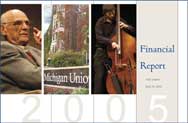

The life sciences are thriving at Michigan, with new faculty at the Life Sciences Institute, $50 million in new funding, and new cancer-related research findings.
 The continued growth of new faculty hiring and research grants led the life sciences news this year.
Six new faculty joined the Life Sciences Institute (LSI), bringing the number of LSI faculty to 17 out of an expected total of 25-30 scientists. “This influx of highly talented scientists from multiple disciplines showcases Michigan’s approach to advancing science,” said LSI Director Alan R. Saltiel. “This group is a dynamic microcosm of the key research areas in the LSI.”
The continued growth of new faculty hiring and research grants led the life sciences news this year.
Six new faculty joined the Life Sciences Institute (LSI), bringing the number of LSI faculty to 17 out of an expected total of 25-30 scientists. “This influx of highly talented scientists from multiple disciplines showcases Michigan’s approach to advancing science,” said LSI Director Alan R. Saltiel. “This group is a dynamic microcosm of the key research areas in the LSI.”
The new faculty in the LSI “laboratory without walls” work in fields such as evolutionary biology, cell biology, human genetics, oncology, pathology, structural biology, and computational biology, a new field combining biology and information science.
The six new faculty are: Jason E. Gestwicki, PhD, Stanford; Patrick J. Hu, MD, PhD, Howard Hughes Medical Institute; Alex Kondrashov, PhD, National Center for Biotechnology Information at the NIH; Noah Rosenberg, PhD, University of Southern California; John Tesmer, PhD, University of Texas at Austin; and Lois Weisman, PhD, University of Iowa.
Four U-M research projects received funding from the latest Michigan Technology Tri-Corridor (MTTC) Fund competition. The projects include research on cancers, infertility, lung disease, and multiple sclerosis. The U-M projects were awarded $5.1 million of the $27.3 million granted to 24 life sciences projects across the state.
U-M’s largest award was a $2.4 million grant for the Proteomics Alliance for Cancer Research, headed by U-M Professor Gilbert Omenn. The Alliance also includes Proteome Research Services of Ann Arbor, GeneGo of New Buffalo/St. Joseph, the Van Andel Research Institute in Grand Rapids, and faculty from multiple departments in the U-M Medical School, College of Engineering, and College of LSA.
Scientists at the Medical School have discovered the biological equivalent of a grocery store bar code on the surface of blood-forming stem cells in mice. The discovery will be valuable to scientists working in the rapidly advancing field of stem cell science.
A U-M team of physicians, scientists, and engineers received $3 million from NASA to determine a way of detecting radiation exposure by looking for individual cells that have been harmed. Radiation kills cells and damages the DNA within them, causing long-term health problems, especially cancers. Scientists can tag individual cells in the bloodstream using man-made nanoparticles called “dendrimers” that signal when a cell dies.
The Michigan Nanotechnology Institute for Medicine and Biological Sciences (M-NIMBS), led by Dr. James R. Baker, Jr., the Ruth Dow Doan Professor of Biologic Nanotechnology, is also exploring the use of dendrimers for drug delivery and improved medical imaging. The nanotechnology equivalent of a “Trojan horse,” a dendrimer can smuggle a powerful chemotherapeutic drug inside tumor cells—increasing the drug’s cancer-killing activity and reducing its toxic ’side effects.
M-NIMBS also received a $6.3 million Grand Challenges in Global Health grant from the Bill and Melinda Gates Foundation. The grant supports development and testing of a nanoemulsion-based vaccine delivery system that uses a nasal swab rather than an injection. The heat-stable system eliminates the need for vaccine refrigeration, often unavailable in developing countries.
In an emergency—like last year’s shortage of vaccine—could the influenza virus be produced faster? U-M professor Henry Wang says yes: twice as fast.
Wang and graduate student Lyle Lash, speaking at the 229th American Chemical Society National Meeting, proposed a system for retrofitting biopharmaceutical buildings to produce the flu vaccine using cell cultures. The approach could cut the production cycle in half, to two months.
Researchers at the U-M’s Comprehensive Cancer Center reported that people who took a type of cholesterol-lowering drug for five years had only half the risk of developing colon cancer, even when they had a family history of the disease or other risk factors. Results of the study appeared in the May 26 issue of the New England Journal of Medicine.
“Statins [such as Zocor, Pravachol, or Lipitor] may have the potential to prevent chronic diseases other than heart disease,” says study author Stephen Gruber, MD, PhD, MPH, associate professor of internal medicine and human genetics at the Medical School and associate professor of epidemiology at the School of Public Health.
Two public health professors now co-direct the Life Sciences and Society Program (formerly Life Sciences, Values, and Society). Sharon Kardia, associate professor of epidemiology, and Toby Citrin, adjunct professor of health management and policy, will lead LSS as it develops training and educational programming.
The National Institute of Allergy and Infectious Diseases has awarded a $5.9 million, five-year contract to the Medical School to create a comprehensive inventory of genes and proteins active in Bacillus anthracis, the bacterium that causes anthrax. The U-M Biodefense Proteomics Research Center is one of seven new NIH-funded centers.
An objective of the Center is to study anthrax at the earliest stages of infection, explains Philip Hanna, PhD, director of the U-M Center and assistant professor of microbiology and immunology in the Medical School. U-M will collaborate with the Scripps Research Institute in La Jolla, California.
U-M scientists have received a $3 million, five-year grant from the National Institutes of Health to develop a new interdisciplinary program to train tomorrow’s leaders in regenerative science. Researchers in this intriguing new area hope to develop cell-based and tissue engineering therapies that can repair damaged tissue or replace dysfunctional organs, says program director Steven A. Goldstein, PhD, U-M’s Henry Ruppenthal Family Professor of Orthopaedic Surgery.
The National Institute on Aging (part of the National Institutes of Health) awarded a five-year grant to U-M’s Michigan Alzheimer’s Disease Research Center.
The new money will continue to fund the Center’s Memory and Aging Project (UM-MAP), a long-term study on memory, aging, and dementia. The grant will also support a special effort to encourage more participation in studies by African Americans, Hispanics, and Asian Americans, so that research results better represent the entire American population.